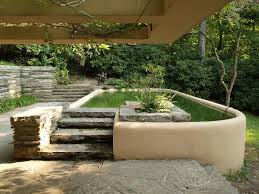
Fallingwater was my next trip. Wearing my black leather jacket and black leather gloves to keep me warm in this freezing weather that was below 20 degrees, I stepped in my car and drove the hour and ten minutes it takes me to reach Fallingwater from my house.
Later on, I would discover that people from all over the world came to see this magnificent place. When I looked in the guestbook that people are allowed to write in (yes, I wrote my name in there as well), I saw a few names with other countries listed next to them. I honestly couldn't believe that people would travel such a great distance to see this "house in the woods." But it's all beautifully built in a natural setting.
The tour guide would say that Fallingwater was nominated to be the eighth wonder of the world in 2013. It lost, but he said it was an honor that it was nominated. Many famous people have visited, such as the Heinz family. Brad Pitt and Angelina Jolie were here as well (as found out from a quick Google search). The tour guide said that Albert Einstein visited, although it isn't documented.

When I saw the architectural wonder, I almost felt like I traveled into the past to the 1930's when Frank Lloyd Wright built the home for the Kaufmann family. It would eventually become a famous National Landmark.

The base labor would be .25 cents an hour, and about .65 or .75 cents an hour for laborers with more advanced skillsets, like plumbers or electricians. Our tour guide said, "Remember, this was the Great Depression. If you quit your job, there was always someone waiting on it."
Based on DollarTimes.com, one dollar "in 1930 had the same buying power as $13.55 in 2014. Annual inflation over this period was 3.15%." Moreover, .25 cents was equal to $3.39 in 2014, 65 cents was equal to $8.81 in 2014, and 75 cents was equal to $10.16 in 2014. Seeing this, it's much easier to see the wage differences, and what buying power they had with the kind of money.
The Kaufmann's planned to spend about $20,000 to $30,000 on building the home. But they would spend $155,000 dollars, which would be worth about 2.4 million dollars as of today.
And look how COLD it was here. Much of the water (apart from the river, which also had snow and frozen water accumulating around the edges near the rocks), was completely frozen.
Just LOOK at that icicle hanging off that pipe. The water was all like, "I stopped running. What happened? I got all frozen and stuff."
I met my tour guide on the bridge, a short, stout old man. He had a thick white beard, and his two hands rested on a long, elegant walking stick.
If you'd look to the right on this short bridge before entering the home, you'd find this beautiful view of the river.
The tour guide said that horizontal lines were important in the architectural design. Even when I merely glanced at the building, it was obvious how important the horizontal line was, even in the bricks themselves.
Escaping the cold and entering the first room, the living room, I felt my body grow warm from head to toe. There was a fireplace crackling with a bright, red fire in a stone hearth near a kitchen and a table. "The Hearth was a focal point," said the tour guide. It brought light, heat, and fellowship. There were two carvings in the stone of what appears to be dragons above the fireplace.
Near the fireplace is an opening that leads to the kitchen--it's small and has colors of white and yellow.
Standing near a long couch and table, I observed a glass casing that was over stairs that led further below. The tour guide called this "The Hatch," which allowed access to the stream below. When opened, a few things happen: The sound of the water and the cool breeze comes up. There's a boiler down there that heats the water.
Fallingwater faces toward the South to take advantage of the light. And the interior floors have wax to give the illusion of wet stone! I thought that was pretty cool. He said that, "Forty-five percent of the home is a terrace."
Wright wanted the family to live with the waterfall, which is why he built the house partly on one, and so it was built around the large rocks. Two columns of chimney help form the vertical floor.

In the 1930's, this heavily wide open space for a living room was unique. It also had a state of the art record player. The freestanding chairs came from the Kaufmann's, from Florence, Italy, and the rest was built by the designer. The foam rubber (used on chairs and furniture) was used for commercial applications, and this is one example of it being used privately.
In the portrait near the table before heading up the stairs is Kaufmann Sr., aged 49, and was created in 1929. Since it is forbidden to take photos in the interior of the home, I cannot provide this picture personally, but I have provided it through a Google search.

Next I was led into the guestroom. It was small, to make the guests feel sheltered, but still connected to the outdoors through the glass. There's a fold on the ceiling to increase the strength of its support of the roof. And the ceiling was designed low to guide the eyes to look outside. The stone floor doesn't have that wax, and the shelves are designed to look like they are floating. The closet is horizontal to match the design and give it extra strength. And the headboard of the bed is fixed to the wall so the location of the bed cannot be changed.
When a member of the tour asked a question about the electric in the house, the tour guide responded that the electric is conduit, and has been rewired.
In the hallways, I noticed a tiny red vent fixed in the stone for ventilation. When I peeked in a bathroom, I noticed that it had a tiny bath.
The tour guide said that the narrow hallways are meant to give the feeling of compression, then when the person entered a wide room, it was meant to give the feeling of release. There was a design theme of compression and release throughout the building.
The tour guide said that bowling alley wax sealed with cork was the bathroom floor, because ceramic tile would be too cold.
Each room had a button on a dresser, so that the housemaid could come and fulfill requests.
The master bedroom housed a Picasso painting and a fireplace, and its bathroom was HUGE. When I walked on the stone patio, my feat slid at the edges of the terrace and I almost slipped forward. I was extra careful to not fall over and into the river below.
Returning inside and back into the warmth, I was led to the auxiliary bedroom, which was also Kaufmann's study and bedroom. He had asked Mr. Wright to design the desk to make it bigger, and so the desk had a curve so that a window would open. Sounds of the river rushes in as soon as the window opens. There are screens on the windows as well, to keep out birds, baths, bugs, and whatever else.
A guest asked why the bed was so small, and the tour guide joked that we guess we know who the boss of the house really is. But the size of the furniture depends on the size of the room.
Mr. Kaufmann and Mr. Wright remained friends their entire lives. Mr. Wright also had built a chapel down the road.
The third level room was the most private room. Kaufmann jr. (he liked to have it spelled lowercase instead of Jr.) didn't have to go through his father's room to get there. This room takes the center of the vertical core of the building. This was his study and he enjoyed the morning light here. He worked at a department store for 7 years, and was an adjunct professor at Columbia. He read many books (as did the entire Kaufmann family).
The redstone was quarried from the site, and is almost a perfect color of red wood.
The sky lights take advantage of the natural light, and the lights are turned on only if it's dark.
There is a semi-circle outside going up the stairs. It's the largest one and is supposed to create the feeling of a gentle walk, and is a 3-step landing. Before being led back inside, I noticed a pool on the patio. The pool has no filter or heater. It's an early use of submerged lighting. And it has no chemicals in it because it drains into Beer Run. People need to drain it, scrub it, refill it, and when it turns green (as shown in the picture), do it all over again to make it clean. Mrs. Kaufmann always swam before breakfast.

The guest house was a comfortable space and was usually called the largest room of the home. Outside, the leaves overhead protects the rain from coming in these small, narrow windows when they are open. In this room was an American Chestnut tree trunk root as a table, upside down, which "goes against nature," as the tour guide said. I was confused by this going against nature since this entire home was about becoming one with nature, it seemed.
The books are all originals in the home. The Kaufmann's loved to read. There were also books in German and French, as they knew three languages. The artwork was Kaufmann jr's responsibility. And Frank Lloyd Wright gave some art as gifts. Mr. Kaufmann also mortgaged his art collections; he was a terrible manager of money.
In Mrs. Kaufmann's room, the tour guide said she loved Chester filled cigarettes (I believe) and margaritas. There were chrome and black water pictures; they are by a thermal company and probably from the store.
Kaufmann Sr's brothers and sisters are still in Pittsburgh, the tour guide explained. Robert Morris University purchased one of (Oliver) Kaufmann's estates to build a campus.
There are about 165,000 visitors each year.
After the tour, I viewed the outside around the building. I saw this weird statue, holding its arms up in the air as if chanting for rain or something. It also had big boobies. Weird.
I believe when this water leak was found, Mr. Kaufmann wanted it to be part of the architecture, and so it was.
The trash is placed in this square-looking containment in a corner outside.
The forest itself is beautiful outside as well.
Walking a long, cold road to get to my car for warmth.
As I drove home, I took a picture of the stone outside that reads "Fallingwater." It turned out artistic, taking a picture behind the passenger window, which was smothered in wet and bits of ice, which gave an interesting effect of it being behind and preserved by a glass portrait.

As I left, I returned to the natural time period. Quite a journey! I actually visited this place as a kid with my father and his family. All I remembered were trees and interesting parts of the house, and taking a bunch of pictures afterward; oh, it was also very cold then, too. And now, being older, I was able to fully digest the experience as an adult.
Interesting journey through time indeed.
(If you want to learn more about Fallingwater, check out their website at http://www.fallingwater.org)

















































